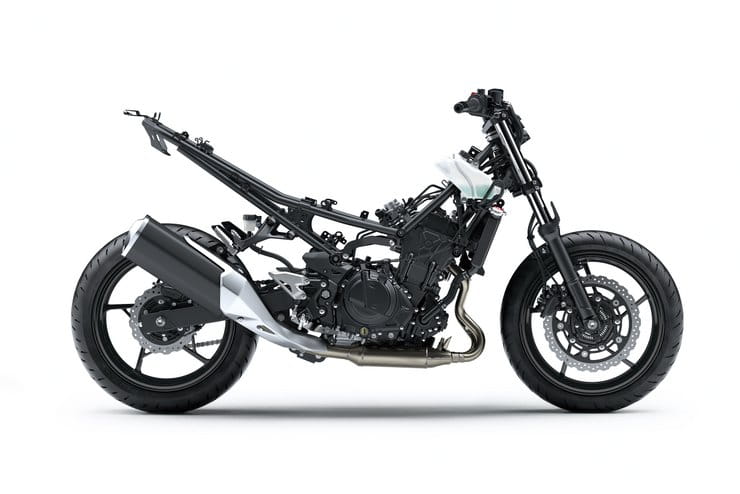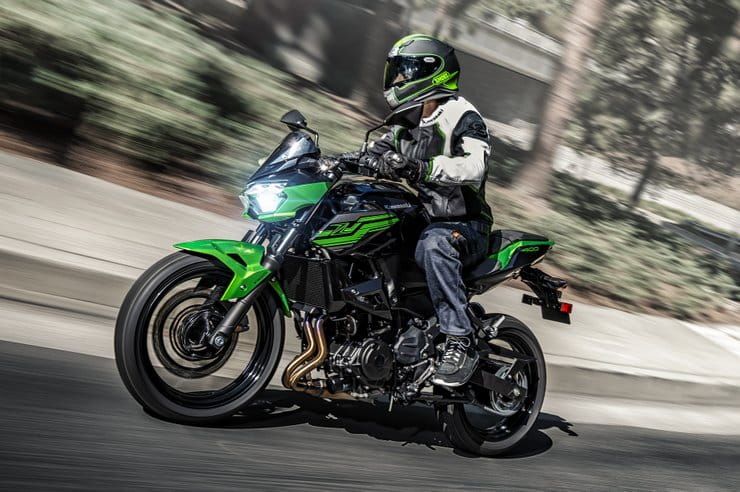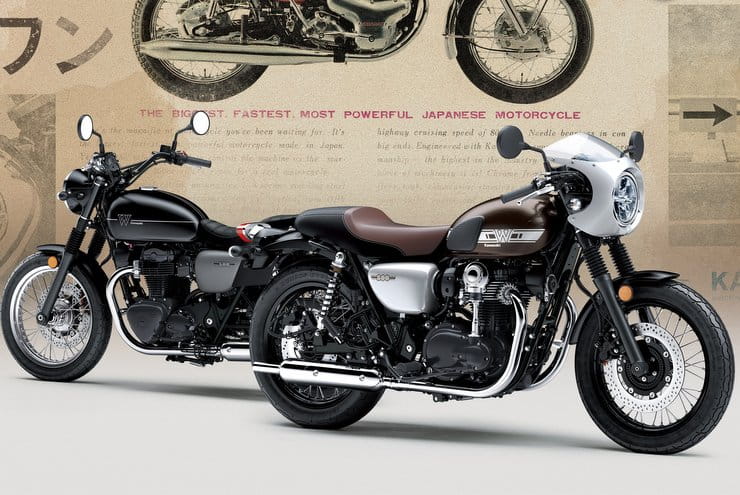Kawasaki has already revealed many of its 2019 models including the updated Ninja H2 and ZX-6R but it still kept four machines back for the EICMA show in Milan.
2019 Kawasaki Versys 1000
Every manufacturer likes to have a contender in the big adventure bike class even though, regardless of their virtues, buyers still flood to the BMW R1250GS at the expense of all its rivals.
The Kawasaki Versys 1000, though, has always been a bit of an outlier. Less ‘adventure’ than most of its competition, it’s more of a high-rise sports-tourer. Its inline-four engine and resolutely road-oriented 17-inch wheels mean there’s no pretence that this is a bike to take you across the Gobi desert, but it remains one that’s more than up to the job of both the daily commuting grind and long-distance touring.
For 2019, the essence is unchanged, but the Versys has been restyled and updated, with two versions – a base Versys 1000 and higher-spec Versys 1000 SE – making up the range.
The 1043cc engine is basically the same as before, with identical performance to the 2018 version at 118hp and 75lb-ft of torque. But it’s leapt into the 20-teens by finally adopting electronic throttle valves, opening the door to much more advanced traction control.
That TC system is now a lean-sensitive “engine and chassis management package” that uses the ubiquitous Bosch IMU. The ABS also uses the same IMU to work in corners as well as straight lines.
On the new SE version, Kawasaki has also added its KECS electronic suspension system, a semi-active setup that reacts to changes in riding style or road surface and allows the damping to be adjusted on the fly. An electronically-adjustable rear preload means you can instantly switch between solo mode, luggage mode and a fully-laden, passenger-and-luggage setting.
The SE also gains Sport, Road, Rain and Rider-adjustable riding modes that link the traction control, suspension and power modes into pre-set packages, while an up-and-down quickshifter means there’s no need to touch the clutch once you’ve got underway. Cornering lights in the fairing sides are another SE-only feature, as is a higher-spec instrument pack that includes a colour screen and Bluetooth connectivity - you can even adjust the suspension from your phone screen, if you so desire. And finally the SE also gets Kawasaki’s self-healing paint, which first appeared on the Ninja H2 and slowly flows back into minor scratches, so they disappear over time.
Cruise control appears on both versions of the bike, as does an adjustable screen – although the SE’s is a taller design. Both bikes also get new styling, with LED headlights adopting Kawasaki’s current family appearance.
2019 Kawasaki Versys 1000 spec
|
Price
|
£TBA
|
|
Expected in dealers
|
TBA
|
|
Power
|
118bhp (88.2kW) @ 8,900rpm
|
|
Torque
|
75lb-ft (102Nm) @ 7,500rpm
|
|
Tank size
|
21 litres
|
|
Seat height
|
840mm
|
|
Wet weight
|
253kg (SE 257kg)
|
2019 Kawasaki Ninja H2 SX SE+
Kawasaki’s supercharged Ninja H2 might not have sparked the sort of forced-induction revolution that some expected after its launch but with the debut of the new H2 SX SE+, Kawasaki now has no fewer than six variations on the supercharged theme in its own line-up.
As the name suggests, the H2 SX SE+ is an uprated version of the already high-spec H2 SX SE. That little “+” sign signifies the inclusion of electronically-adjustable, semi-active suspension with built-in stroke sensors. SX SE indeed. Those sensors feed information back to the ECU, which also takes information from the Bosch IMU and the engine computer to decipher exactly what the bike is doing at any given moment. It can then adjust the suspension automatically to suit, with a reaction time of just 1 millisecond.
Four riding modes – Sport, Road, Rain and Rider – and three payload settings (rider only, rider and luggage, rider with passenger and luggage), complete the suspension’s party tricks.
The SX SE+ also gets higher-spec Brembo Stylema Monobloc brake calipers, colour TFT instruments, smartphone connectivity and Kawasaki’s self-healing paint, as used on the 2019 H2 and the new Versys 1000 SE.
2019 Kawasaki Ninja H2 SX SE+ spec
|
Price
|
£TBA
|
|
Expected in dealers
|
TBA
|
|
Power
|
197.3bhp (147.1kW) @ 11,000rpm
|
|
Torque
|
101.3lb-ft (137.3Nm) @ 9,500rpm
|
|
Tank size
|
19 litres
|
|
Seat height
|
835mm
|
|
Wet weight
|
262kg
|
2019 Kawasaki Z400
Ever since Kawasaki released the Ninja 400 a year ago it’s been pretty clear that there’s a hole in the range for a naked version of the same bike. And now that hole has been plugged with the new Z400.
A replacement for the old Z300, the new machine is, quite simply, a stripped-back version of the Ninja 400. It’s got the same trellis frame, the same A2-licence-legal 399cc parallel twin engine and the same suspension and brakes. Where it differs is in its wide bars and unfaired styling.
Adopting a family look that brings it into line with the rest of the ‘Z’ range – now including seven models ranging from the new Z125 to the Z1000R – the Z400’s new elements include its LED headlight, front end bodywork and its own unique instrument pack with a LCD ‘needle’ for its rev counter, allied to a digital speedo, gear position indicator and fuel gauge.
2019 Kawasaki Z400 spec
|
Price
|
£TBA
|
|
Expected in dealers
|
TBA
|
|
Power
|
44.8bhp (33.4kW) @ 10,000rpm
|
|
Torque
|
28lb-ft (38Nm) @ 8,000rpm
|
|
Tank size
|
14 litres
|
|
Seat height
|
785mm
|
|
Wet weight
|
167kg
|
2019 Kawasaki W800
Kawasaki’s W800 retro bike never managed to make a huge dent in a segment dominated by the likes of Triumph’s Bonneville, but with the British bike now water-cooled and starting at 900cc, there’s an opening for an authentically air-cooled retro lower down in the market. So a couple of years after Euro4 emissions laws killed the original W800, for 2019 Kawasaki is bringing it back.
The firm’s EICMA announcement is more of a pre-release, with the firm promising full details in early 2019. However, while the new model is still 773cc and air-cooled, like the old W800, and retains its distinctive bevel-driven camshaft, it’s now Euro4-legal and Kawasaki says the bike is “90% new”.
There will be two versions, a naked W800 Street and a bullet-faired W800 CAFE, both using a completely redesigned steel tube chassis. The range mimics the last generation of W800, and while the new models look remarkably similar to their predecessors, there are styling changes to be seen. Most notably both versions have shorter, bobbed front and rear mudguards and smaller turn signals, and lack the chrome tank badging of the last generation. They also feature new seats, most notably on the CAFE model, which loses the over-the-top pillion hump of the previous model in favour of a sleeker, lower design. The headlight, while still sticking with the traditional look, is now an LED unit.
Kawasaki has confirmed that the bike’s maximum power will be an A2-legal 35kW (47hp), and that unlike the previous generation there will be disc brakes at both ends, complete with ABS.
2019 Kawasaki W800 spec
|
Price
|
£TBA
|
|
Expected in dealers
|
TBA
|
|
Power
|
47bhp (35kW)
|
|
Torque
|
TBA
|
|
Tank size
|
TBA
|
|
Seat height
|
TBA
|
|
Wet weight
|
TBA
|
























